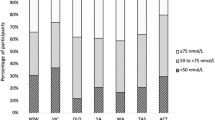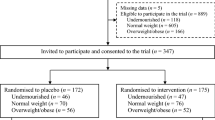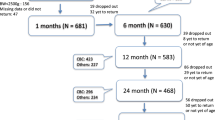Abstract
Objectives: To examine seasonality of 25-hydroxyvitamin D (25OH-D) levels in British preschool children and the effect of vitamin D supplementation on this.
Design: The National Diet and Nutrition Survey of children aged 1.5–4.5 y in Britain during 1992–3 measured dietary intakes and blood status indices, including those for vitamin D, during all four seasons. The present study addresses the seasonal dependence of the relation between vitamin D intake and status.
Setting: 100 randomly selected postcode sectors throughout Britain, whose locations were classified as (a) Scotland; (b) Northern England; (c) Central, Wales, South+SW; (d) London+SE.
Subjects: Of 1859 whose parents or guardians were interviewed, 1675 provided a weighed diet estimate, and blood vitamin D status (25OH-D) was measured in 756, with approximately equal numbers in each season.
Results: Vitamin D status is highly dependent on season: moreover, the relation between vitamin D intake and status is also seasonally dependent, being strong in the winter and negligible in the summer. During the winter, those children who had relatively low 25OH-D concentrations generally were those not receiving vitamin D supplements. Vitamin D intakes and supplement use were lower in the north than in the south of Britain.
Conclusions: For British preschool children, dietary vitamin D is of much greater importance in the winter than in the summer. There is evidence of regional inequality, with lesser use of supplements in the north. Supplements are needed in the winter, to achieve satisfactory vitamin D status and minimise the risk of rickets and of poor bone health, especially in high-risk groups.
Sponsorship: This study was part of the National Diet and Nutrition Survey of Children Aged 1.5–4.5 y, which was funded jointly by the Ministry of Agriculture, Fisheries and Food and the Department of Health, and was conducted by the Social Survey Division of the Office of Population Censuses and Surveys (now the Office for National Statistics) and the MRC Dunn Nutritional Laboratory (now MRC Human Nutrition Research).
This is a preview of subscription content, access via your institution
Access options
Subscribe to this journal
Receive 12 print issues and online access
$259.00 per year
only $21.58 per issue
Buy this article
- Purchase on Springer Link
- Instant access to full article PDF
Prices may be subject to local taxes which are calculated during checkout
Similar content being viewed by others
Author information
Authors and Affiliations
Contributions
Peter Davies coordinated the biochemical aspects of the survey and wrote the first draft of the manuscript; Christopher Bates revised the manuscript and acts as guarantor; Timothy Cole provided expert statistical advice and assistance; Ann Prentice provided expert advice on vitamin D status and requirements; Perronella Clarke initiated the study, provided expert advice on policy implications, and helped to write the final manuscript
Rights and permissions
About this article
Cite this article
Davies, P., Bates, C., Cole, T. et al. Vitamin D: seasonal and regional differences in preschool children in Great Britain. Eur J Clin Nutr 53, 195–198 (1999). https://doi.org/10.1038/sj.ejcn.1600697
Received:
Revised:
Accepted:
Published:
Issue Date:
DOI: https://doi.org/10.1038/sj.ejcn.1600697
Keywords
This article is cited by
-
Vitamin D status of 3-year-old children in Denmark: determinants and associations with bone mineralisation and blood lipids
European Journal of Nutrition (2023)
-
Low vitamin D deficiency in Irish toddlers despite northerly latitude and a high prevalence of inadequate intakes
European Journal of Nutrition (2018)
-
Vitamin D and skeletal health in infancy and childhood
Osteoporosis International (2014)
-
A global representation of vitamin D status in healthy populations
Archives of Osteoporosis (2012)
-
Dietary sources and sociodemographic and economic factors affecting vitamin D and calcium intakes in Flemish preschoolers
European Journal of Clinical Nutrition (2011)



